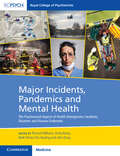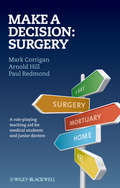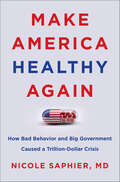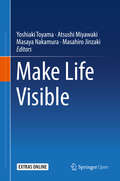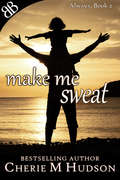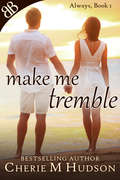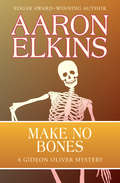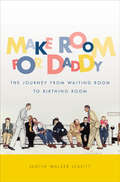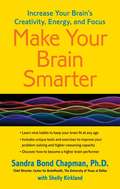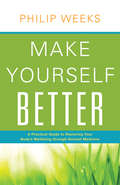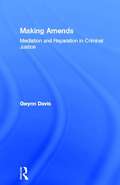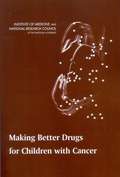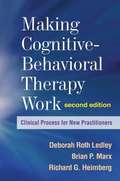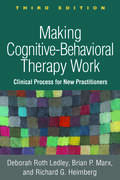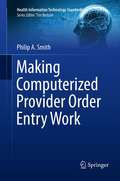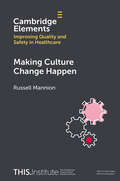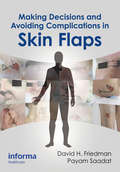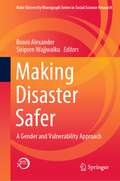- Table View
- List View
Major Incident Medical Management and Support: The Practical Approach in the Hospital (Advanced Life Support Group Ser.)
by Advanced Life Support GroupThis is the course book for a new ALSG course on preparation for and medical management of major incidents within the hospital. It will be a companion volume to MIMMS, which deals with the prehospital situation, and will meet an ever increasing need as natural and other disasters affect hospital staff and administrators. The course aims to provide a systematic approach for all personnel who would be involved in managing a major incident in the hospital. This title is now available for the PDA, powered by Skyscape - to buy your copy Click here
Major Incident Medical Management and Support: The Practical Approach in the Hospital (Advanced Life Support Group)
by Advanced Life Support Group (ALSG)The new edition of Major Incident Medical Management and Support is a vital component in the blended learning course from Advanced Life Support Group (ALSG), which aims to provide hospital staff at all levels with essential information on the preparation, management and support elements of dealing with casualties in a major incident. Split into five sections, each focuses on the elements requisite in preparing for, and responding, to a major incident. The first section discusses the epidemiology and incidences of major incidents and the structured approach to the hospital response. The second section contains the preparation required in planning for major incidents, including equipment and training. The third section covers the management of a major incident, concentrating on the clinical, nursing and management hierarchies. The fourth includes the various stages of support in a major incident, including declaring an incident and activating the plan, the reception, triage, definitive care and recovery phases of an incident. The final section focuses on special incidents which require additional consideration, including those involving hazardous chemicals, burns and children. Written in collaboration with the National Emergency Planning, Major Incident Medical Management and Support is an invaluable reference in the emergency department and beyond for staff needing to prepare for the rare, but inevitable, hospital major incidence response.
Major Incidents, Pandemics and Mental Health: The Psychosocial Aspects Of Health Emergencies, Incidents, Disasters And Disease Outbreaks
by Richard Williams John Drury Keith Porter Verity Kemp Tim HealingMajor Problems in the History of American Medicine and Public Health: Documents and Essays (Major Problems in American History Series)
by John Harley Warner Janet A. TigheThis text presents a carefully selected group of readings on medical history and development that allow students to evaluate primary sources, test the interpretations of distinguished historians, and draw their own conclusions.
Make A Decision: Surgery
by Paul Redmond Arnold Hill Mark CorriganYou're the general surgeon on call. It is you who has to decide every course of action over your shift. Make the right decisions or face the consequences... Taking a role-playing approach, Make A Decision: Surgery allows you to be the book's main character - Dr A. Simpson - a junior general surgeon on call in a busy teaching hospital. Your decisions and actions determine the clinical outcomes of real patients within a number of scenarios. Each scenario branches out and unfolds as you make more decisions, but choose incorrectly and you may be sent home by your boss! Every decision you make is scored and evidence-based feedback is presented at the end of each scenario together with the correct clinical response and an explanation of what actually happened to the patient. Blood work and radiological investigations presented in typical clinical formats allow you to practise your data interpretation skills, whilst your skills in clinical communication are tested to the full as you interact with patients and their families as well as co-members of staff. Based on first-hand experience, the authors have selected real cases that have impacted on their practice and reflect important points of learning, making the book perfect for medical students, junior doctors, and surgery trainees who are looking for a scenario-based, interactive way to learn. For further information and online interactive medical teaching visit www.pilgrimshospital.com
Make America Healthy Again: How Bad Behavior and Big Government Caused a Trillion-Dollar Crisis
by Nicole SaphierNATIONAL BESTSELLER!If Americans want to know why their health care is so costly and getting costlier, they need only look in the mirror.Americans are notoriously unhealthy—we eat too much, drink too much, and sit too much. When roughly 80 percent of cardiovascular disease and 40 percent of all cancer cases could be prevented by simple lifestyle changes, it is time to take a deeper look at the problem and ask who is truly responsible. Consider that: · After seventy years of innovation, heart disease and cancer remain the top two causes of death in the United States.· In 1960, health care spending was 5 percent of America's GDP; today, it is 17.5 percent.· The government spends over $1 trillion annually on health care.· Nearly one in five American deaths is associated with poor diets.· Simply reducing sodium intake by 1,200 mg per day could save up to $20 billion a year in medical costs. In Make America Healthy Again, Nicole Saphier, a Memorial Sloan Kettering physician, nationally recognized patient advocate, and media personality, reveals how individual negligence and big government incompetence have destroyed America’s health care system. Combining historical events, economic trends, and essential lifestyle advice, with her unique perspective, she offers concrete solutions to address this epic problem.We don’t need socialized medicine—we need to take better care of ourselves. By getting healthier and adopting preventative measures, Saphier believes, we can reduce the astronomical costs of treatment and improve overall care. The only way to lower medical costs for everyone is to stop incentivizing bad health decisions. Policies such as the Affordable Care Act and single-payer plans ignore something crucial to lowering the overall financial burden: personal responsibility. We can no longer expect doctors and the government to fix illnesses we have the power to prevent. Regardless of which health policy is adopted, our nation will flounder unless we take action. It is up to the American people to make America healthy again.
Make Life Visible
by Masaya Nakamura Yoshiaki Toyama Atsushi Miyawaki Masahiro JinzakiThis open access book describes marked advances in imaging technology that have enabled the visualization of phenomena in ways formerly believed to be completelyimpossible. These technologies have made major contributions to the elucidation of the pathology of diseases as well as to their diagnosis and therapy. The volume presents various studies from molecular imaging to clinical imaging. It also focuses on innovative, creative, advanced research that gives full play to imaging technology inthe broad sense, while exploring cross-disciplinary areas in which individual research fields interact and pursuing the development of new techniques where they fuse together. The book is separated into three parts, the first of which addresses the topic of visualizing and controlling molecules for life. Th e second part is devoted to imaging of disease mechanisms, while the final part comprises studies on the application of imaging technologies to diagnosis and therapy. Th e book contains the proceedings of the 12th Uehara International Symposium 2017, “Make Life Visible” sponsored by the Uehara Memorial Foundation and held from June 12 to 14, 2017. It is written by leading scientists in the field and is an open access publication under a CC BY 4.0 license.
Make Me Listen (Always #3)
by Cherie M Hudson"...story is one that is unique but meaningful enough that it’ll definitely stick with me. I HIGHLY recommend this novel to those looking for an incomparable contemporary new adult romance! 5 Stars, Jess at From Me to YouIt was all background noise, until he made her stop and listen!Chase is tough, snarky, witty and fiercely loyal to her family. She is also hearing impaired, which makes the world around her sound like white noise a lot of the time. But that’s okay, she can deal. It’s not like she’s actually deaf, and she’s learned to lip read…when it suits her.What she can’t deal with is guys like Caden, who think their looks and charm will win her over. They won’t, because Chase has zero interest in pursuing a relationship with someone who's leaving the country soon. What would be the point?Well, there is the fun they have together. The way Caden shows he cares about things greater than himself, like abandoned dogs. There’s his smile, his eyes and his wicked sense of humour.In fact if Chase ever admitted it to herself, she might say Caden is just about perfect.Until he reminds her that the male of the species can’t always be trusted…A portion of the proceeds from sales of Make Me Listen will benefit Dogs for Better Lives!Previously Published: (2015) Momentum | Original Title: UndeniableThe Always series is perfect for fans of Still Alice by Lisa Benova, Magic Hour by Kristin Hannah and Close Enough to Touch by Colleen Oakley.Books in the Always series:1. Make Me Tremble2. Make Me Sweat3. Make Me Listen
Make Me Sweat (Always #2)
by Cherie M Hudson“...this is a book I am not likely to forget ever; the masterful storytelling will stick with me, the characters have my heart…” Five Stars, Slick Reads ReviewsI’m Brendon: an optimist, a fitness geek, a man with a plan and the drive to achieve it. I’m sure I know everything there is to know about my life and where it’s headed—until I get one brief text.A text from her.Thinking of you.Just three little words, but they’re enough to make me drop everything and head half way around the world to see her. I guess I was kidding myself about being over Amanda.I don’t know what to expect when we reconnect, but nothing can prepare me for the truth.A truth she kept from me who has my eyes and claims my heart in an instant.And a devastating diagnosis with the power to destroy all I never knew I held dear.International bestselling author Cherie M Hudson delivers a stunning tale that will touch your heart. Book 2 in her bestselling Always series, Make Me Sweat takes you on a journey of disappointment, second chances, and undying love!The Always series is perfect for fans of Still Alice by Lisa Benova, Magic Hour by Kristin Hannah and Close Enough to Touch by Colleen Oakley.A portion of the proceeds from sales of Make Me Sweat will benefit The Leukemia Research FoundationPreviously Published: (2015) Momentum | Original Title: UnforgettableBooks in the Always series:1. Make Me Tremble2. Make Me Sweat3. Make Me Listen
Make Me Tremble (Always #1)
by Cherie M Hudson“One of the BEST New Adult Coming of Age romance books I’ve read…funny, heartwarming and sexy…” Slick ReadsLife’s great – it’s the terminal degenerative disease that sucks.Maci is young, smart and about to embark on the adventure of a lifetime. It looks like she has the world at her feet, but appearances can be deceiving. Because Maci is not like other college girls. She already knows her future is written and there’s no happy ending in sight.For Raphael, life is all upside. He’s on the fast track to success and nothing can stop him—except his unexpected love for a girl who’s convinced she’ll hold him back.When Maci and Raphael are drawn irresistibly together, they’ll both have to redefine everything they thought they knew about life, love and happy ever after.International bestselling author Cherie M Hudson pens a poignant tale that will keep you turning the pages from start to finish. Book 1 in her bestselling Always series, Make Me Tremble takes you on a journey that will touch your heart.A portion of the proceeds from sales of Make Me Tremble will benefit The Michael J. Fox Foundation for Parkinson's Research.The Always series is perfect for fans of Still Alice by Lisa Benova, Magic Hour by Kristin Hannah and Close Enough to Touch by Colleen Oakley.Previously Published: (2016) Momentum | Original title: UnconditionalBooks in the Always series:1. Make Me Tremble2. Make Me Sweat3. Make Me Listen
Make No Bones: Curses!, Icy Clutches, And Make No Bones (The Gideon Oliver Mysteries #7)
by Aaron ElkinsThe forensic anthropologist wonders who would steal the bones of a deceased colleague—and why: &“A likable, down-to-earth, cerebral sleuth.&” —Chicago Tribune There is not much left of the irascible Albert Evan Jasper, &“dean of American forensic anthropologists,&” after his demise in a fiery car crash. But in accord with his wishes, his remains—a few charred bits of bone—are installed in an Oregon museum to create a fascinating if macabre exhibit. All agree that it is a fitting end for a great forensic scientist—until what is left of him disappears in the midst of the biannual meeting (a.k.a., the &“bone bash and weenie roast&”) of the august WAFA—the Western Association of Forensic Anthropologists—in nearby Bend, Oregon. Like his fellow attendees, Gideon Oliver—the Skeleton Detective—is baffled. Only the WAFA attendees could possibly have made off with the remains, but who in the world would steal something like that? And why? All had an opportunity, but who had a motive? Soon enough, the discovery of another body in a nearby shallow grave will bring to the fore a deeper, more urgent mystery, and when one of the current attendees is found dead in his cabin, all hell breaks loose. Gideon Oliver is now faced with the most difficult challenge of his career—unmasking a dangerous, brilliant killer who knows every bit as much about forensic science as he does. Or almost. Make No Bones is the 7th book in the Gideon Oliver Mysteries, but you may enjoy reading the series in any order.
Make Room for Baby: Perinatal Child-Parent Psychotherapy to Repair Trauma and Promote Attachment
by Alicia F. Lieberman Manuela A. Diaz Gloria Castro Griselda Oliver BucioThis state-of-the-art clinician's guide describes Perinatal Child–Parent Psychotherapy (P-CPP), a treatment for pregnant women and their partners whose readiness to nurture a baby is compromised by traumatic stress and adverse life experiences. An application to pregnancy of the widely disseminated, evidence-based Child–Parent Psychotherapy, P-CPP spans the prenatal period through the first 6 months of life. Extended cases illustrate ways to help mothers and fathers understand how trauma has affected them, navigate the physical and emotional challenges of becoming parents, build essential caregiving competencies, and ensure the safety of their babies and themselves. Cultural considerations in working with diverse families are addressed through specific intervention examples.
Make Room for Daddy: The Journey from Waiting Room to Birthing Room
by Judith Walzer LeavittUsing fathers' first-hand accounts from letters, journals, and personal interviews along with hospital records and medical literature, Judith Walzer Leavitt offers a new perspective on the changing role of expectant fathers from the 1940s to the 1980s. She shows how, as men moved first from the hospital waiting room to the labor room in the 1960s, and then on to the delivery and birthing rooms in the 1970s and 1980s, they became progressively more involved in the birth experience and their influence over events expanded. With careful attention to power and privilege, Leavitt charts not only the increasing involvement of fathers, but also medical inequalities, the impact of race and class, and the evolution of hospital policies. Illustrated with more than seventy images from TV, films, and magazines, this book provides important new insights into childbirth in modern America, even as it reminds readers of their own experiences.
Make Your Brain Smarter: Increase Your Brain's Creativity, Energy, and Focus
by Shelly Kirkland Sandra ChapmanThe most powerful, most staggeringly complex machine ever created is all in your head. Our brain is the most adaptable, modifiable organ in our body, and yet it is the organ we most likely give the least attention. Many individuals who are concerned with having a physically fit body stop their "workout" at the neck. In the past five years brain scientists have discovered much more about how the brain works, including that it can be trained to perform better than ever before. You are never too young or too old to adopt healthy brain habits that strengthen the brain's capacity to think smarter. In Make Your Brain Smarter, renowned cognitive neuroscientist Dr. Sandra Bond Chapman introduces you to the very latest research in brain science and shows you how to tailor a program to fit your own needs. In this all-inclusive book, Dr. Chapman delivers a comprehensive "fitness" plan that you can use to "exercise" your way to a healthier brain. You will find scientifically proven strategies to train deep, insightful, and strategic thinking. You will discover why memory is not the most important measure of brain function, why IQ is an outdated, misleading index of brain potential, and how to become a higher brain performer. Make Your Brain Smarter is the ultimate guide for keeping your brain fit at every age. You will learn why age is not the culprit behind brain slippage, why your brain does not have to deteriorate, why your best brain years can be ahead of you, and how to maximize brainpower across the life span. Whether you are a Boomer-age "thinker" or a Millennial-era "finder," Make Your Brain Smarter will help you take charge of your frontal lobe command center, in order to create and challenge yourself to achieve the bright and vibrant brain that you crave, and to be a more creative, more articulate, and more energetic thinker. Brain performance is the last, most urgent, and most significant frontier of human performance. Now is the time to put your brain at the center of your health habits. Live young and live long with a brain whose assets can continue to grow more valuable when you take the health challenge to keep your brain fit every day.
Make Yourself Better: A Practical Guide to Restoring Your Body's Wellbeing through Ancient Medicine
by Philip WeeksApplying his deep understanding of holistic medical traditions from both East and West, Philip Weeks guides the reader through the process of restoring the body's wellbeing using a simple combination of natural techniques, diet and herbal medicines. He explores five key interconnected areas through which wellbeing can be attained - nourishment; detoxification; lifestyle; activation; and mind, emotions and spirit - based on his analogy of the wheel of health. The author explores in depth the importance of good nutrition and detoxification, with clear explanations of specific methods and techniques and of the general principles to adhere to. He includes simple recipes and clinically-tested detoxification plans. The health benefits of activity and physical exercise are explored, as are the effects of potentially harmful substances such as mercury, additives and plastics, and the simple steps that can be taken to avoid these. He also looks in a holistic way at specific emotional difficulties the reader may be faced with, such as anger, stress and grief, and at how to deal with these in order to achieve wellbeing on a mental, emotional and spiritual level. Compassionate and realistic, Make Yourself Better will empower the reader to make more informed choices in their day-to-day life to achieve a greater level of health and vitality.
Making Amends: Mediation and Reparation in Criminal Justice
by Gwynn DavisReparation, or making amends, is an ancient theme in criminal justice. It was revived in both Europe and North America in the 1980s as a practical alternative both to retributivism, and to the various utilitarian projects traditionally associated with retributive justice.Making Amends examines the practice of these schemes in the UK, USA, and Germany, and shows how criminal justice institutions were unresponsive to these attempts to cast justice in a new form. Yet the experiments reflected an abiding dissatisfaction with criminal courts and with the manner in which justice is conceived and expressed within the criminal framework. The authors' conclusions therefore have implications for the workings of the criminal justice system as a whole.
Making Better Drugs for Children with Cancer
by Institute of Medicine National Research Council of the National AcademiesThe National Academies Press (NAP)--publisher for the National Academies--publishes more than 200 books a year offering the most authoritative views, definitive information, and groundbreaking recommendations on a wide range of topics in science, engineering, and health. Our books are unique in that they are authored by the nation's leading experts in every scientific field.
Making Cancer History: Disease and Discovery at the University of Texas M. D. Anderson Cancer Center
by James S. OlsonThe history of the M. D. Anderson Cancer Center vividly reveals how cancer treatment in America—and our attitudes toward the disease—has changed since the middle of the twentieth century.One of the preeminent cancer centers in the world, M. D. Anderson is also one of the first medical institutions devoted exclusively to caring for people with cancer and researching treatments and cures for the disease. Historian James S. Olson’s narrative relates the story of the center’s founding and of the surgeons, radiologists, radiotherapists, nurses, medical oncologists, scientists, administrators, and patients who built M. D. Anderson into the world-class institution it is today. Through interviews with M. D. Anderson’s leaders and patients, Olson brings to life the struggle to understand and treat cancer in America. A cancer survivor who has himself been treated at the center, Olson imbues this history with humor, passion, and humanity.
Making Choices for Healthcare
by Frank Honigsbaum Stefan Holmstrom Johann CalltorpFirst Published in 2018. CRC Press is an imprint of Taylor & Francis, an Informa company.
Making Cognitive-Behavioral Therapy Work, Second Edition
by Deborah Ledley Brian MarxUsed around the world by novice clinicians as well as experienced therapists new to cognitive-behavioral therapy (CBT), this bestselling book has been widely adopted as a text in clinical training programs. The authors provide a vivid picture of what it is actually like to do CBT and offer practical guidance for becoming a more skilled and confident clinician. Vignettes and examples illustrate the entire process of therapy, from intake and assessment to case conceptualization, treatment planning, intervention, and termination. Expert advice is given on building collaborative therapeutic relationships and getting the most out of supervision. Appendices feature recommended treatment manuals and other CBT resources. New to This Edition Reflects the latest knowledge and clinical tools. Discussions of working with suicidal clients, culturally responsive CBT, integrating CBT with other approaches, professional ethics in the Internet age, and more. Discussion of case conceptualization has been extensively revised and made even more user-friendly.
Making Cognitive-Behavioral Therapy Work, Third Edition: Clinical Process for New Practitioners
by Deborah Roth Ledley Brian P. Marx Richard G. Heimberg"What should I do when a client asks me personal questions?" "How do my client's multiple problems fit together, and which ones should we focus on in treatment?" This engaging text--now revised and updated--has helped tens of thousands of students and novice cognitive-behavioral therapy (CBT) practitioners build skills and confidence for real-world clinical practice. Hands-on guidance is provided for developing strong therapeutic relationships and navigating each stage of treatment; vivid case material illustrates what CBT looks like in action. Aided by sample dialogues, questions to ask, and helpful checklists, readers learn how to conduct assessments, create strong case conceptualizations, deliver carefully planned interventions, comply with record-keeping requirements, and overcome frequently encountered challenges all along the way. New to This Edition *Chapter with advice on new CBT practitioners' most common anxieties. *All-new case examples, now with a more complex extended case that runs throughout the book. *Chapter on working with special populations (culturally diverse clients, children and families). *Special attention to clinical and ethical implications of new technologies and social media. *Updated throughout to reflect current research and the authors' ongoing clinical and teaching experience.
Making Computerized Provider Order Entry Work
by Philip SmithDespite all the jokes about the poor quality of physician handwriting, physician adoption of computerized provider order entry (CPOE) in hospitals still lags behind other industries' use of technology. As of the end of 2010, less than 22% of hospitals had deployed CPOE. Yet experts claim that this technology reduces over 80% of medication errors and could prevent an estimated 522,000 serious medication errors annually in the US. Even though the federal government has offered $20 billion dollars in incentives to hospitals and health systems through the 2009 stimulus (the ARRA HITECH section of the American Recovery and Reinvestment Act of 2009), many organizations are struggling to implement advanced clinical information systems including CPOE. In addition, industry experts estimate that the healthcare industry is lacking as many as 40,000 persons with expertise in clinical informatics necessary to make it all happen by the 2016 deadline for these incentives. While the scientific literature contains numerous studies and stories about CPOE, no one has written a comprehensive, practical guide like Making CPOE Work. While early adopters of CPOE were mainly academic hospitals, community hospitals are now proceeding with CPOE projects and need a comprehensive guide. Making CPOE Work is a book that will provide a concise guide to help both new and experienced health informatics teams successfully plan and implement CPOE. The book, in a narrative style, draws on the author's decade-long experiences of implementing CPOE at a variety of academic, pediatric and community hospitals across the United States.
Making Culture Change Happen (Elements of Improving Quality and Safety in Healthcare)
by Russell MannionHealthcare policy frequently invokes notions of cultural change as a means of achieving improvement and good-quality care. This Element unpacks what is meant by organisational culture and explores the evidence for linking culture to healthcare quality and performance. It considers the origins of interest in managing culture within healthcare, conceptual frameworks for understanding culture change, and approaches and tools for measuring the impact of culture on quality and performance. It considers potential facilitators of successful culture change and looks forward towards an emerging research agenda. As the evidence base to support culture change is rather thin, a more realistic assessment of the task of cultural transformation in healthcare is warranted. Simplistic attempts to manage or engineer culture change from above are unlikely to bear fruit; rather, efforts should be sensitive to the complexity and highly stratified nature of culture in an organisation as vast and diffuse as the NHS. This title is also available as Open Access on Cambridge Core.
Making Decisions and Avoiding Complications in Skin Flaps
by David H. Friedman Payam SaadatWith a large number of clinical photographs, Making Decisions and Avoiding Complications in Skin Flaps is an atlas intended for the surgeon who already has a grasp of the fundamentals and mechanics of flap repair, but may need additional ideas on selecting an appropriate flap for a given defect. Divided into three sections, the book begins with a s
Making Disaster Safer: A Gender and Vulnerability Approach (Kobe University Monograph Series in Social Science Research)
by Siriporn Wajjwalku Ronni AlexanderThis edited book was produced through a transnational and transdisciplinary UNESCO Chair Project on Gender and Vulnerability in Disaster Risk Reduction Support. Contributors come from five disaster-prone Asian countries, and the chapters reflect their rich knowledge and practical experience in disaster management and humanitarian assistance. The chapters, all with a focus on gender and vulnerability, illustrate that gender can make people, especially women, vulnerable. The chapters address the experiences of state and non-state actors responding to disaster and promoting recovery at the local level. However, while women and vulnerable people may be victims of disasters, they also serve as agents for recovery and voices for better disaster preparedness. In sharing both successes and failures, as well as suggestions for the future, this book speaks to the need for transdisciplinary knowledge and multilevel coordination, as well as full equality for all genders and respect for human rights, in order to cope with increasingly more frequent, intense, and complex emergencies. This book is of interest as a text to students in a variety of disciplines who are focusing on disaster and health emergencies, as well as to practitioners and others promoting disaster risk reduction and resilience.


